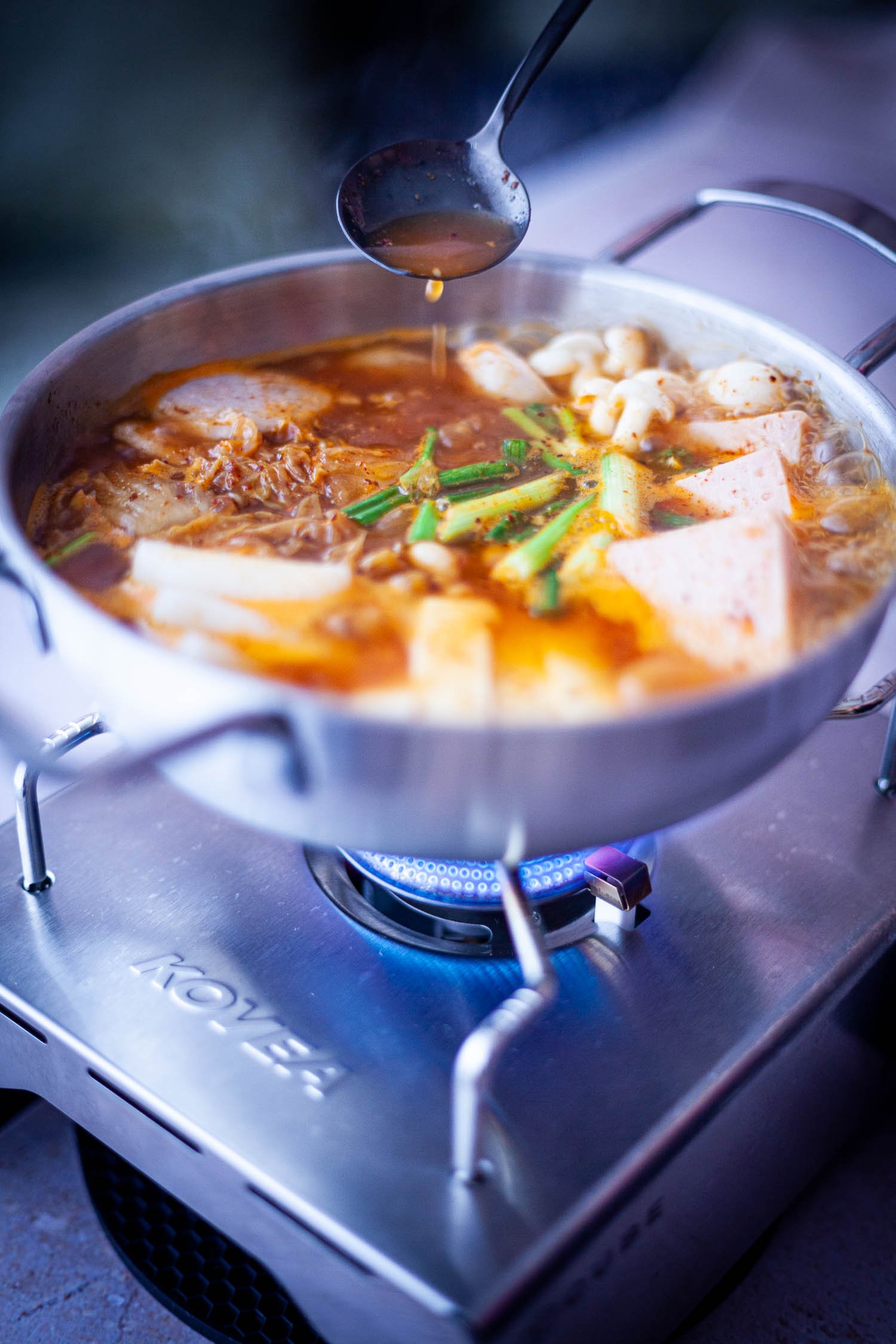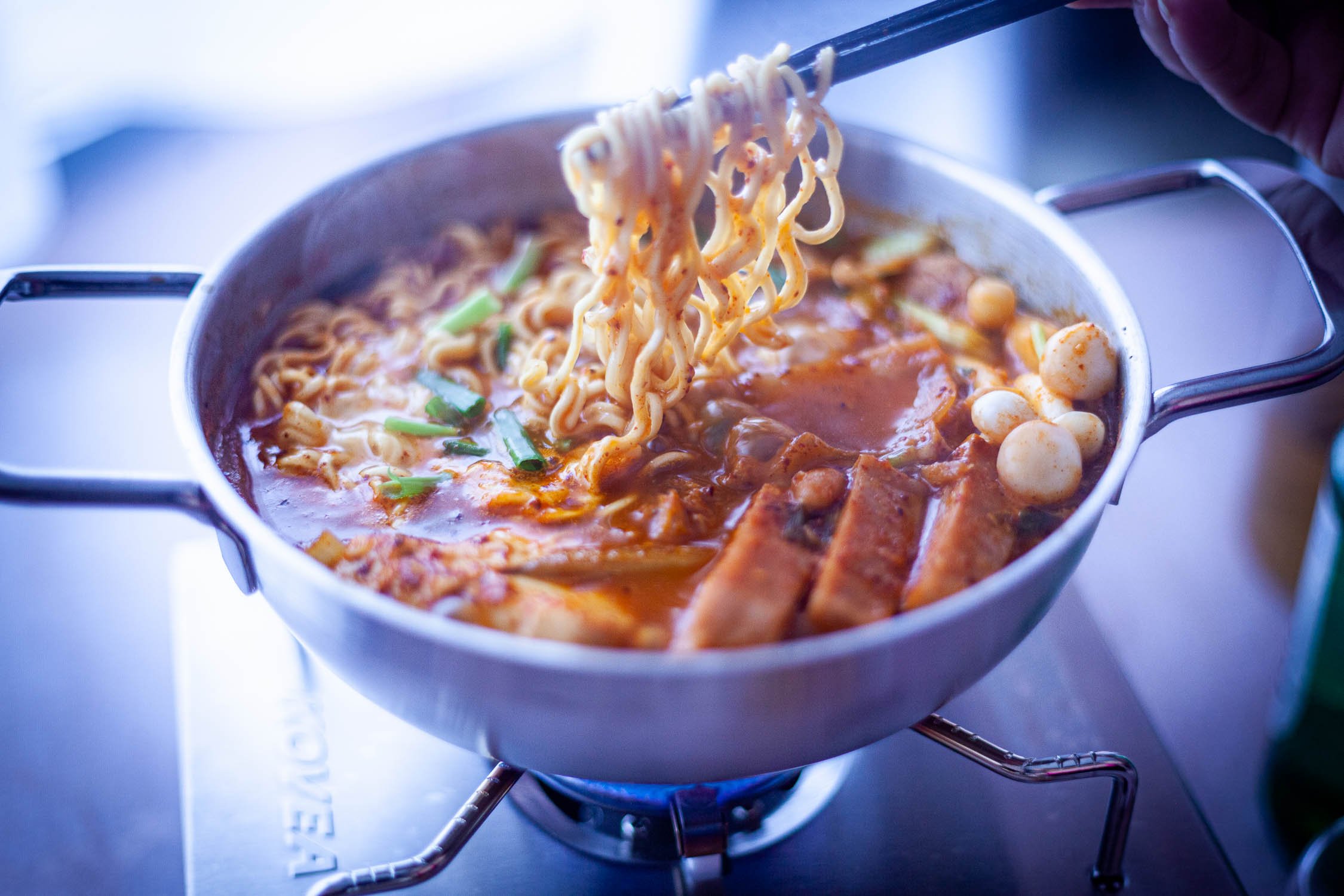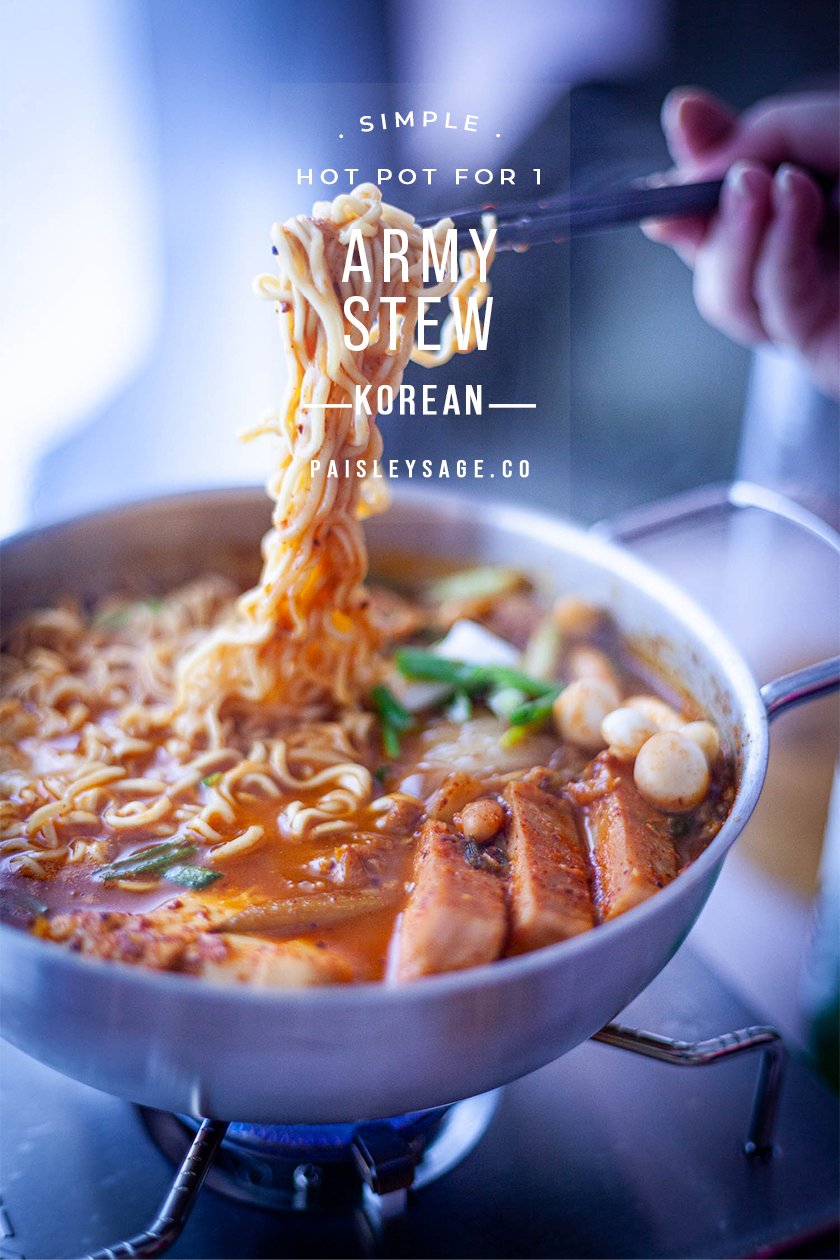Hot Pot Budae Jjigae — The Ultimate Go-To One Pot Meal
let it simmer & sizzle, and dazzle your palate !
Budae Jjigae, a.k.a Korean Army Stew is not foreign to those of us who are into Korean food and culture. This Korean hot pot, which can be cooked easily at home, is one of my all-time favorite hot pots because it is so satisfying and so easy to make. In fact, it is a one pot meal which I make often for myself at home and I think you would too after you have tried it. It definitely falls under the comfort food and easy to cook meals categories—a dish which you can count on whenever you need some warmth and comforting, as well as serve as a quick fix to replenish your energy tank. The subtle heat gives a nice kick too. Have this slightly spicy, very savory Army Stew over the weekend and let it refresh and restore you, and help you kick start the work week ahead.
Hot pots are normally served in big portion sizes for two and more diners at the restaurants so if you are home alone and craving for a sizzling hot pot, this hot pot recipe is easy to make for yourself in the comfort of your home. All you need to do is prepare and assemble each ingredient into one pot with the soup seasoning paste, fill it with broth or filtered water, turn on the burner, and eat to your heart’s content as it simmers and sizzles away.
One reason I make this Budae Jjigae recipe more often than other hot pot recipes is because I can enjoy a delicious hot pot even when I have not pre-made any hot pot broth from scratch or have any store-bought broths in my pantry. Most hot pot recipes are highly dependent on the soup base it used. This Korean Army Stew recipe depends more on the soup seasoning paste for flavour than the broth itself, so I can use filtered water as the soup base and still have a delicious-tasting hot pot. This makes it more convenient to cook than other hot pot recipes.
Also, this recipe is very flexible. You can interchange the ingredients with whatever you prefer or have in your fridge. The recipe I included here is the classic version of Budae Jjigae where it calls for processed meats such as spam and sausages, and canned baked beans. However, as some of you already know, I try to avoid eating processed foods as much as I can so I usually substitute the processed meats with fresh cuts of meats—for example, pork belly, pork shoulder, minced beef, beef sukiyaki and chicken shabu shabu. You can also substitute the canned beans with freshly cooked beans, and ramen noodles with other noodles of your choice if you would like. I like using Korean sweet potato starch noodles (dangmyeon) and also fresh egg noodles. Don’t forget to choose natural cheese over processed cheese. By the way, you can also make this Budae Jjigae recipe on the stove top and transfer it to the table and eat it like a regular meal instead of having it in hot pot style.
recipe card
OVERVIEW
SERVINGS: 1—2
CUISINE TYPE: ASIAN | KOREAN
PREP TIME: APPROX. 15 MINS
COOK TIME: APPROX. 5—10 MINS
LEVEL: EASY
INGREDIENTS YOU’LL NEED
HALF A YELLOW ONION, THINLY SLICED
1 GOURMET SAUSAGE, BITE-SIZED PCS (3/4 CUP | 100 G)
WHITE SHIMEJI OR ENOKI MUSHROOMS, CLEANED & ROOTS DISCARDED (1/2 CUP | 50 G)
NON-GMO TOFU, FIRM, BITE-SIZED PCS (1 CUP | 150 G)
GREEN ONIONS, 1—2 STALKS, 1-INCH PCS
FROM THE PANTRY
RICE CAKES (3/4 CUP | 100 G)
PREMIUM SPAM, BITE-SIZED PCS (1/2 CAN | 150 G)
CANNED BAKED BEANS (2 TBSP)
KIMCHI, HOMEMADE OR STORE-BOUGHT, BITE-SIZED PCS (1/2—1 CUP)
BROTH OF YOUR CHOICE OR FILTERED WATER (2—3 CUPS)
RAMEN NOODLES (1 PACK)
NATURAL CHEDDAR CHEESE, SLICED (1—2 PCS)
For The Soup Seasoning Paste:
KOREAN RED PEPPER PASTE ‘GOCHUJANG’ (1 TBSP)
GARLIC, MINCED (1 TSP)
KOREAN RED PEPPER FLAKES ‘GOCHUGARU’ (1 TSP)
LIGHT SOY SAUCE (2 TSP)
RAW CANE SUGAR (1 TSP)
KITCHEN TOOLS
SMALL BOWL
CUTTING BOARD
KNIFE
MINI POT (7-INCH OR 8-INCH)
TABLESPOON
TEASPOON
CHOPSTICKS
PORTABLE BURNER
BUTANE GAS CANISTER
STEPS
1
Soak the dried rice cakes in cold filtered water in a small bowl beforehand (about 30 minutes), then drain and assemble the rice cakes in a pot. If you are using fresh rice cakes, you can skip this step.
2
In the meantime, prepare each ingredient. First, cut the onion into thin slices. Then cut the spam, sausage and tofu into bite-sized pieces. After which, cut the green onions into 1-inch pieces. If you are using whole kimchi, cut it into bite-sized pieces too. Cut the kimchi last so that you don’t have to wash the cutting board halfway through. Also, assemble each ingredient in the pot as you prepare them so that you don’t have to use additional dishes.
3
Next, clean the mushrooms and discard its roots, and then assemble in the pot with the other ingredients.
4
Open the canned baked beans and add some into the pot.
5
Combine all the ingredients for the soup seasoning paste in the small bowl that was used to soak the rice cakes previously so that you don’t have to use additional bowls. Add the seasoning paste to the pot when done.
6
Set up a portable burner on the dining table and transfer the pot onto the burner. Add the broth or filtered water to the pot.
7
Turn the burner on high heat and bring the broth and ingredients in the pot to a boil and until the rice cakes are al dente (about 5 —10 minutes). Then lower the heat and let it simmer while you tuck in. Add the ramen and cheddar cheese to the pot whenever you are ready, and feel free to add more ingredients, broth and seasoning paste as the meal proceeds. Enjoy!
*NOTES
As much as possible, use broth instead of filtered water for nutrition. I used anchovy broth which I pre-made with dried shiitake mushrooms, anchovies and kelp. You can use any store-bought broths too, but check the label to ensure that the broth you picked is as natural as possible, with no undesirable additives and preservatives.
I usually soak the dried rice cakes overnight in the fridge to cut down the prep time on the actual hot pot day.
Feel fee to add more Korean red pepper flakes (gochugaru) if you like more heat in your stew.
If you don’t mind the number of dirty dishes at the end of the meal, you may choose not to assemble all the ingredients into the pot at once, but have each ingredient lay out in a dish and place them around the hot pot to be gradually added into the pot as the meal proceeded—in traditional hot pot style. I do this when I have guests over.
Have ready more broth, seasoning paste and ingredients for topping up if the meal is going to be an extended one.
You can use an electric cooker instead of the portable burner if that is more convenient for you.
COOKING FOR ONE
This recipe is developed for the ‘Cooking For One’ Video Series and is designed with efficiency and ease in mind for the Solo diner. The goal is to encourage Solos who live alone to cook for themselves by making the process quick, effortless and hassle free. It is a simple one-pot meal; is just 1–2 servings so there is little to no leftovers; and very minimal cleanup at the end of the meal by intentionally using the same or very few kitchenware to cook and serve with throughout.
*SOME TIPS
As this is a more elaborate Meal For One than usual, more ingredients are required in this recipe.
To minimise the number of dirty dishes, I deliberately assembled each ingredient in the pot as I prepared them so that I didn’t need to use additional dishes. I reused the small bowl used to soak the rice cakes previously for mixing the seasoning paste and for serving when I tucked into the hot pot. I also used the same tablespoon for both measuring and for serving. The total sink load at the end of the meal is kept to seven counts.
TOTAL SINK LOAD FOR THIS MEAL : 7
“
SHARING IS CARING.
SUPPORT FUTURE CONTENT BY SHARING THIS WITH YOUR FRIENDS USING THE SOCIAL LINKS BELOW.
”

















































































